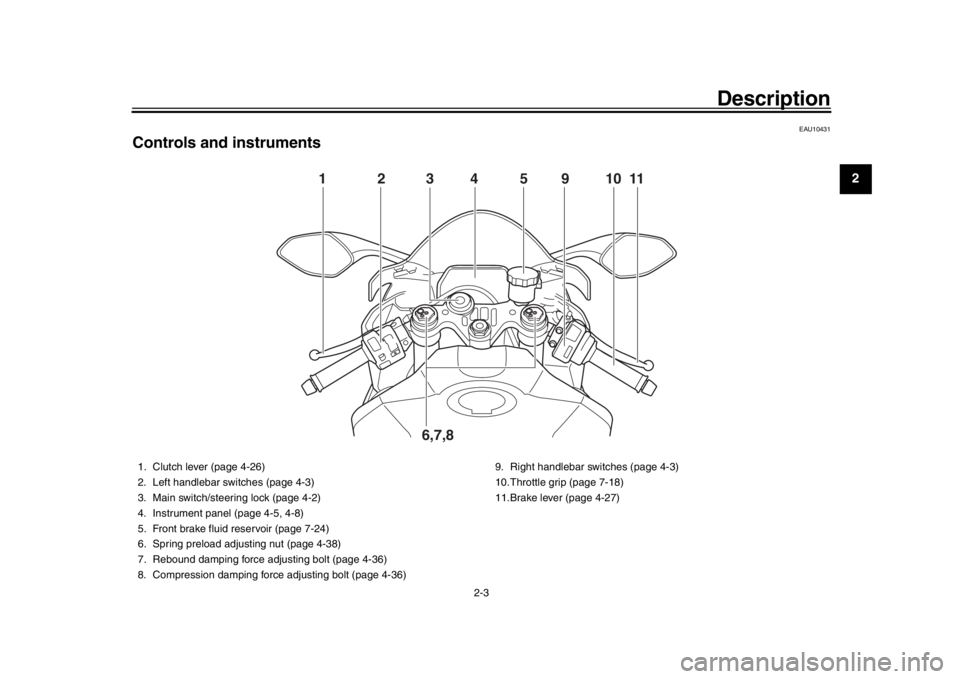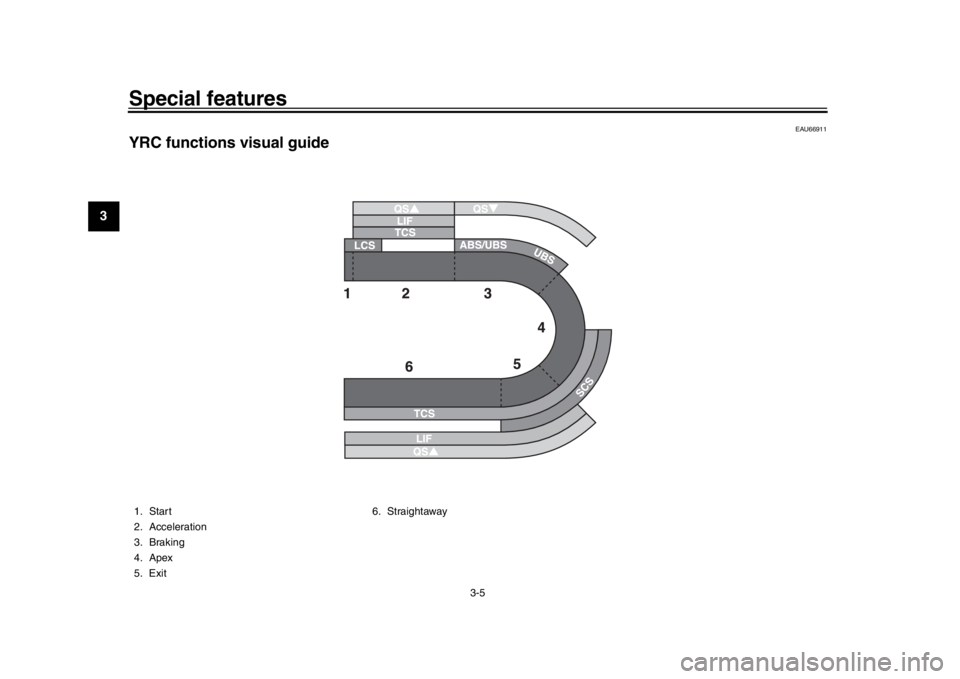YAMAHA YZF-R1 2019 User Guide
Manufacturer: YAMAHA, Model Year: 2019, Model line: YZF-R1, Model: YAMAHA YZF-R1 2019Pages: 124, PDF Size: 9.58 MB
Page 11 of 124

Safety information
1-4
12
3
4
5
6
7
8
9
10
11
12
dorse nor recommend the use of ac-
cessories not sold by Yamaha or
modifications not specifically recom-
mended by Yamaha, even if sold and
installed by a Yamaha dealer.
Aftermarket Parts, Accessories,
and Modifications
While you may find aftermarket prod-
ucts similar in design and quality to
genuine Yamaha accessories, recog-
nize that some aftermarket accessories
or modifications are not suitable be-
cause of potential safety hazards to you
or others. Installing aftermarket prod-
ucts or having other modifications per-
formed to your vehicle that change any
of the vehicle’s design or operation
characteristics can put you and others
at greater risk of serious injury or death.
You are responsible for injuries related
to changes in the vehicle.
Keep the following guidelines in mind,
as well as those provided under “Load-
ing” when mounting accessories.
Never install accessories or carry
cargo that would impair the perfor-
mance of your motorcycle. Care-
fully inspect the accessory before using it to make sure that it does
not in any way reduce ground
clearance or cornering clearance,
limit suspension travel, steering
travel or control operation, or ob-
scure lights or reflectors.
Accessories fitted to the handle-
bar or the front fork area can
create instability due to improper
weight distribution or aerody-
namic changes. If accessories
are added to the handlebar or
front fork area, they must be as
lightweight as possible and
should be kept to a minimum.
Bulky or large accessories may seriously affect the stability of
the motorcycle due to aerody-
namic effects. Wind may at-
tempt to lift the motorcycle, or
the motorcycle may become un-
stable in cross winds. These ac-
cessories may also cause
instability when passing or being
passed by large vehicles.
Certain accessories can dis- place the operator from his or
her normal riding position. This
improper position limits the free- dom of movement of the opera-
tor and may limit control ability,
therefore, such accessories are
not recommended.
Use caution when adding electri-
cal accessories. If electrical acces-
sories exceed the capacity of the
motorcycle’s electrical system, an
electric failure could result, which
could cause a dangerous loss of
lights or engine power.
Aftermarket Tires and Rims
The tires and rims that came with your
motorcycle were designed to match the
performance capabilities and to provide
the best combination of handling, brak-
ing, and comfort. Other tires, rims, siz-
es, and combinations may not be
appropriate. See page 7-19 for tire
specifications and for information on
servicing and replacing your tires.
Transporting the Motorcycle
Be sure to observe following instruc-
tions before transporting the motorcy-
cle in another vehicle.
Remove all loose items from the
motorcycle.
BX4-9-E2.book 4 ページ 2018年9月6日 木曜日 午後4時39分
Page 12 of 124

Safety information
1-5
1
2
3
4
5
6
7
8
9
10
11
12
Check that the fuel cock (if
equipped) is in the off position and
that there are no fuel leaks.
Shift the transmission into gear (for
models with a manual transmis-
sion).
Secure the motorcycle with
tie-downs or suitable straps that
are attached to solid parts of the
motorcycle, such as the frame or
upper front fork triple clamp (and
not, for example, to rubber-mount-
ed handlebars or turn signals, or
parts that could break). Choose
the location for the straps carefully
so the straps will not rub against
painted surfaces during transport.
The suspension should be com-
pressed somewhat by the
tie-downs, if possible, so that the
motorcycle will not bounce exces-
sively during transport.
BX4-9-E2.book 5 ページ 2018年9月6日 木曜日 午後4時39分
Page 13 of 124

2-1
123
4
5
6
7
8
9
10
11
12
Description
EAU10411
Left view
12
645
7
3
1. Fuses (page 7-33)
2. Fuel tank cap (page 4-30)
3. Drive chain puller (page 7-26)
4. Spring preload adjusting ring (page 4-38)
5. Shift pedal (page 4-27)
6. Engine oil level check window (page 7-12)
7. Engine oil filter cartridge (page 7-12)
BX4-9-E2.book 1 ページ 2018年9月6日 木曜日 午後4時39分
Page 14 of 124

Description
2-2
12
3
4
5
6
7
8
9
10
11
12
EAU10421
Right view
4
3
567
2
1
8,9,10
1. Battery (page 7-32)
2. Front brake fluid reservoir (page 7-24)
3. Document storage space (page 4-35)
4. Coolant reservoir cap (page 7-16)
5. Engine oil filler cap (page 7-12)
6. Brake pedal (page 4-28)
7. Rear brake fluid reservoir (page 7-24)
8. Fast compression damping force adjuster (page 4-36) 9. Slow compression dampi
ng force adjuster (page 4-38)
10.Rebound damping forc e adjuster (page 4-38)
BX4-9-E2.book 2 ページ 2018年9月6日 木曜日 午後4時39分
Page 15 of 124

Description
2-3
123
4
5
6
7
8
9
10
11
12
EAU10431
Controls and instruments
1234 9 51011
6,7,8
1. Clutch lever (page 4-26)
2. Left handlebar switches (page 4-3)
3. Main switch/steering lock (page 4-2)
4. Instrument panel (page 4-5, 4-8)
5. Front brake fluid reservoir (page 7-24)
6. Spring preload adjusting nut (page 4-38)
7. Rebound damping force adjusting bolt (page 4-36)
8. Compression damping force adjusting bolt (page 4-36) 9. Right handlebar switches (page 4-3)
10.Throttle grip (page 7-18)
11.Brake lever (page 4-27)
BX4-9-E2.book 3 ページ 2018年9月6日 木曜日 午後4時39分
Page 16 of 124

3-1
1
23
4
5
6
7
8
9
10
11
12
Special features
EAU85760
YRC (Yamaha Ride Control)Yamaha Ride Control is a system that
incorporates numerous sensors and
controls to support an improved riding
experience. The vehicle senses and
can react to forces along the longitudi-
nal (front-to-back), lateral (left-to-right),
and vertical (up-and-down) axes. Lean
angle and G-force accelerations are
also detected. This information is pro-
cessed multiple times a second and the
related physical systems are automati-
cally adjusted as necessary. The fol-
lowing functions represent individual
YRC items which can be turned on/off
or adjusted to suit various riders and
riding conditions. For setting details,
see pages 4-10 and 4-14.
WARNING
EWA18221
The Yamaha Ride Control (YRC) sys-
tem is not a substitute for the use of
proper riding techniques or the ex-
pertise of the operator. This system
cannot prevent loss of control
caused by rider errors such as trav-
eling faster than warranted by road
and traffic condition s, including lossof traction due to excessive speed
when entering turns, when acceler-
ating hard at a sharp lean angle, or
while braking, and it cannot prevent
front wheel slip or front wheel lift. As
with any motorcycle, always ride
within in your limits, be aware of sur-
rounding conditions, and ride ap-
propriately for those conditions.
Become thoroughly familiar with the
way the motorcycle handles with
various YRC settings before at-
tempting more advanced maneu-
vers.
PWR
The power delivery mode system con-
sists of four different control maps
which regulate throttle valve opening in
relation to the degree of throttle grip op-
eration, thus providing you with a selec-
tion of modes to fit your preferences
and the riding environment.
TCS
The traction control system helps main-
tain traction when accelerating. If sen-
sors detect that the rear wheel is
starting to slip (uncontrolled spinning),
the traction control system assists by
regulating engine power as needed un-
til traction is restored. The traction con-
trol system indicator/warning light
flashes to let the rider know that traction
control has engaged.
This traction control system automati-
1. PWR 1
2. PWR 2
3. PWR 3
4. PWR 4
5. Throttle valve opening
6. Throttle grip operation
5
64
3 2
1
BX4-9-E2.book 1 ページ 2018年9月6日 木曜日 午後4時39分
Page 17 of 124

Special features
3-2
1
234
5
6
7
8
9
10
11
12
cally adjusts accordin
g to the vehicle’s
lean angle. To maximize acceleration,
when the vehicle is upright a less
amount of traction control is applied.
When cornering, a greater amount of
traction control is applied.
TIP
The traction control system may
engage when the vehicle travels
over a bump.
You may notice slight changes in
engine and exhaust sounds when
the traction control or other YRC
systems engage.
When TCS is turned off, SCS,
LCS, and LIF are also turned offautomatically.
WARNING
EWA15432
The traction control system is not a
substitute for riding appropriately
for the conditions. Traction control
cannot prevent loss of traction due
to excessive speed when entering
turns, when accelerating hard at a
sharp lean angle, or while braking,
and cannot prevent front wheel slip-
ping. As with any motorcycle, ap-
proach surfaces that may be
slippery with caution and avoid es-pecially slippery surfaces.
When the key is turned to “ON”, the
traction control system automatically
turns on. The traction control system
can be turned on or off manually only
when the key is in the “ON” position and
the motorcycle is stopped.TIPTurn the traction control system off to
help free the rear wheel if the motorcy-
cle gets stuck in mud, sand, or othersoft surfaces.
NOTICE
ECA16801
Use only the specified tires. (See
page 7-19.) Using different sized
tires will prevent the traction control
system from controlling tire rotationaccurately.
SCS
The slide control system regulates en-
gine power output when a sideward
slide is detected in the rear wheel. It ad-
justs power output based on data from
the IMU. This system supports the TCS
to contribute to a smoother ride.
LCS
The launch control system helps the rid-
er achieve smooth and swift launches
from the starting grid. It keeps engine
speed from rising above 8,000 r/min
even when the throttle grip is fully
turned. The LCS regulates engine pow-
er output in conjunction with the TCS
and LIF systems for optimal traction and
reduced wheel lift.
TCS
BX4-9-E2.book 2 ページ 2018年9月6日 木曜日 午後4時39分
Page 18 of 124

Special features
3-3
1
23
4
5
6
7
8
9
10
11
12
NOTICE
ECA22950
Even when using LCS, the clutch le-
ver must be released gradually toavoid clutch damage.TIPLCS is intended for track use only.
QSS
The quick shift system allows for clutch
lever-less, electronically-assisted shift-
ing. When the sensor on the shift rod
detects the appropriate motion in the
shift pedal, engine power output is mo-
mentarily adjusted to allow for the gear
change to occur.
QSS does not operate when the clutch
lever is pulled, therefore normal shifting
can be done even when QSS is set to
on. Check the QS indicator for current
status and usability information. Upshifting conditions
Vehicle speed of at least 20 km/h
(12 mi/h)
Engine speed of at least 2200 r/min
Accelerating (open throttle)
Downshifting conditions
Vehicle speed of at least 20 km/h
(12 mi/h)
Engine speed of at least 2000 r/min
Engine speed sufficiently away
from red zone
Decelerating and throttle ful-
ly-closed
TIP
QS and QS can be individu-
ally set.
Shifting into or out of neutral mustbe done using the clutch lever.
LIF
The lift control system reduces the rate
at which the front wheel will continue to
rise during extreme acceleration, such
as during starts or out-of-corner exits.
When front-wheel lift is detected, en-
gine power is regulated to slow front-wheel lift while still providing good
acceleration.
QSS usability Indicator Situation
Upshifting OK Accelerating
Downshifting
OK Decelerating
QSS cannot be
used Stopped
QSS turned off Turned off
BX4-9-E2.book 3 ページ 2018年9月6日 木曜日 午後4時39分
Page 19 of 124

Special features
3-4
1
234
5
6
7
8
9
10
11
12
EAU85770
GlossaryABS - Anti-lock Brake System
ABS ECU - Anti-lock Brake System
Electronic Control Unit
ECU - Engine Control Unit
IMU - Inertial Measurement Unit
LCS - Launch Control System
LIF - Lift Control System
PWR - Power delivery mode
QS - Quick Shift
QSS - Quick Shift System
SC - Stability Control
SCS - Slide Control System
TCS - Traction Control System
UBS - Unified Brake System
YRC - Yamaha Ride Control
BX4-9-E2.book 4 ページ 2018年9月6日 木曜日 午後4時39分
Page 20 of 124

Special features
3-5
1
23
4
5
6
7
8
9
10
11
12
EAU66911
YRC functions visual guide1. Start
2. Acceleration
3. Braking
4. Apex
5. Exit 6. Straightaway
BX4-9-E2.book 5 ページ 2018年9月6日 木曜日 午後4時39分